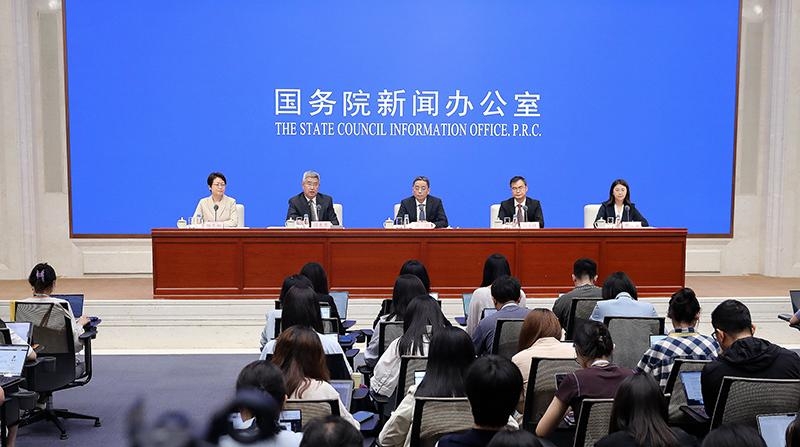21st Century Business Herald:
This year, the PBC introduced a series of incremental policies to support technology finance and took innovative steps to launch a sci-tech board in the bond market. What is the latest progress and achievements? What are the considerations for the next step? Thank you.
Zou Lan:
We will have Ms. Cao from the Financial Market Department answer this question.
Cao Yuanyuan:
Thank you for your questions. The work on technology finance is crucial for implementing an innovation-driven development strategy and ensuring the financial sector serves the real economy. This year, in accordance with the decisions and plans of the CPC Central Committee and the State Council, the PBC, together with relevant departments, introduced two incremental initiatives. One is the optimization of relending facilities for sci-tech innovation and technical transformation. The other is the launch of a sci-tech board in the bond market. These initiatives have advanced the development of a sci-tech ecosystem through credit, bond and equity channels, achieving good results so far.
First, the relending facility for sci-tech innovation and technical transformation has expanded significantly. The policy has increased in scale, reduced interest rates and broadened coverage. By the end of May 2025, banks have signed agreements for sci-tech innovation and technical upgrading loans totaling 1.7 trillion yuan, 1.9 times that of the end of 2024. Outstanding loans reached 614 billion yuan, supporting 15,000 sci-tech small- and medium-sized enterprises (SMEs) in securing their first-ever bank financing, providing financial support for 3,983 equipment renewal projects in key fields.
Second, the launch of a sci-tech board in the bond market is an innovative measure to support technology finance. It supports the issuance of sci-tech innovation bonds by three types of institutions through differentiated arrangements in the bond issuance and trading systems. That is, financial institutions, sci-tech enterprises and equity investment institutions. As of June 30, since its launch in May, 288 entities in the bond market have issued sci-tech innovation bonds totaling approximately 600 billion yuan, of which over 400 billion yuan were issued in the interbank market. This has not only promoted the cultivation and growth of emerging and future industries but also provided strong support for traditional industries to utilize new technological achievements.
Among the three types of issuers of sci-tech innovation bonds, today I would like to focus on the sci-tech innovation bonds issued by equity investment institutions. As we know, equity investment institutions are a major force for long-term capital investment. They typically invest in early-stage projects, small enterprises and advanced core technologies. However, these institutions are often asset-light entities facing long investment cycles. In the past, such institutions have rarely been financed through bond issuance, and investors were quite cautious about bonds issued by these equity investment institutions. Consequently, their financing costs were relatively high. To facilitate bond issuance by equity investment institutions, we have specifically created a risk-sharing facility for sci-tech innovation bonds. Supported by the PBC's low-cost relending funds, this facility, together with local governments and market-oriented credit enhancement institutions, provides a package of incremental support, including guarantees for bond issuance by equity investment institutions and Credit Risk Mitigation Warrants. In addition, the risk-sharing facility also supports the issuance of sci-tech innovation bonds through direct investment.
As of June 30, a total of 27 equity investment institutions in the interbank market had issued 15.35 billion yuan in sci-tech innovation bonds. Notably, five were privately owned institutions that benefited from credit enhancement through risk-sharing instruments, resulting in three policy effects: First, longer bond terms. Through diversified maturity structures with embedded options, these institutions issued bonds with tenors of five years and even up to 10 years, which better match the characteristics and financing needs of equity investment funds. Second, lower issuance costs. The bond issuance rates for these private institutions were relatively low, ranging from 1.85% to 2.69%, with strong market demand. It should be noted that these bonds were backed by guarantees from risk-sharing tools, so the issuance rates reflect the credit of those tools, significantly reducing financing costs for private equity investment institutions. Third, stronger support for innovation capital formation. The institutions that issued bonds generally have extensive investment experience, strong performance records and excellent management teams. They are key players in early-stage, small-scale, long-term and hard-tech investments. The funds raised through these bonds are used for establishing or expanding private equity investment funds, effectively leveraging the leadership role of fund managers and encouraging greater private capital investment in the technology innovation sector.
Moving forward, the PBC will continue to collaborate with relevant departments to make full use of risk-sharing tools for sci-tech innovation bonds. The central and local governments will coordinate efforts to promote development of the technology innovation bond market. This will help nurture a robust financial ecosystem to support technological innovation and provide stronger financial backing for achieving high-level technological self-reliance. Thank you.


 Share:
Share: 




 京公網安備 11010802027341號
京公網安備 11010802027341號